- Home
- Encyclopedia
- Albert Bierstadt: Landscapes of The American West
Albert Bierstadt: Landscapes of the American West
German-American artist Albert Bierstadt captured a transformative time in American history. His travels through Wyoming and the West gave Bierstadt a one-of-a-kind perspective for painting his best-known works in the 1850s and 1860s, and his grandiose landscapes and their idealized, pristine panoramas have sparked the imagination of generations.
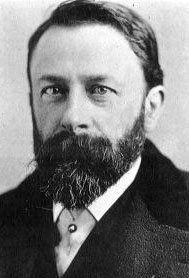
Bierstadt was born on Jan. 7, 1830, in Solingen, Germany, the youngest of six children of Christina and Henry Bierstadt. While Albert was still a toddler, the family left aboard the Hope, bound for America. Leaving a region of Germany still recovering from Napoleonic Wars, they established themselves in New Bedford, Mass., where they settled into American life.
Albert attended local public schools. Little is known about his artistic influences before he was 20, but surely he showed aptitude for the arts in his youth; he was highly capable as a very young adult.
Early training
While in his early twenties, Bierstadt returned to Germany and studied painting in Düsseldorf. He spent four years in Europe, painting and traveling as he refined his craft and began to build a reputation. Already skilled, he found great opportunity to study the work of many master painters.
His artistic style was significantly influenced by his time in Europe, and his body of work shows strong influence in the style of traditional landscape. He later used the sweeping environments of established European traditions of art to influence his painting as he created a new image of the American West.
Bierstadt returned to New Bedford in 1857. Not one to rest, he soon established a studio and began to work in earnest, beginning with sketches and ideas he had cultivated during his European travels. Private and public sales helped the artist to raise his profile and win notice on a broadening scale. His work was well received on a private level, and he worked to expand his career beyond the boundaries of his community, looking to the promise of New York City for sales, prestige and opportunity.
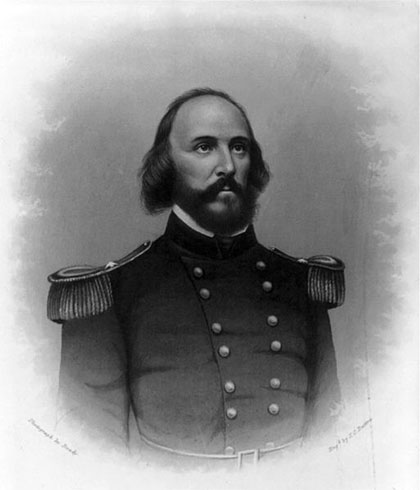
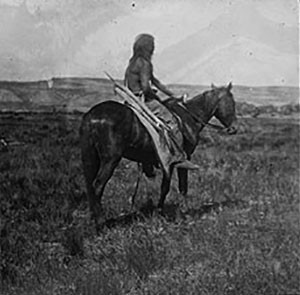
|
While establishing a strong career on the East Coast, Bierstadt was also looking for new opportunities and inspiration. Like many before him, he was drawn to the West; westward expansion and exploration proved to be too great a temptation for the artist to ignore.
West with Lander to Wyoming
In 1859, he traveled with the engineer Fredrick W. Lander on his expedition to build a new, U.S. government road, a shortcut from South Pass on the Oregon-California Trail in what’s now southwest Wyoming to Fort Hall in present Idaho. Bierstadt saw many things new to him on this trip: land, plants, animals, people and their traditions. He journeyed through Nebraska Territory and what’s now Wyoming, where he completed his first landscapes of the American West.
Also that summer, Bierstadt had a camera with him, and in addition to painting pictures he took a number of photos with a wet-plate process that was then quite new. Later the process was perfected by better-known photographers like Matthew Brady and William Henry Jackson. These photos are some of the earliest ever taken in Wyoming. Two show wagons on the new road west of South Pass. Others show Lakota Sioux people at Fort Laramie, and Shoshone people further west.
His paintings from that summer showed sweeping panoramas and western wildlife. The paintings from the Wind River Range of Wyoming, for example, show the viewer how awe-inspired the artist was by the seemingly endless landscape, untouched by the modern world. Clearly, it made a positive impression on him. His work of the West was well received, and he returned to the region time and again.
On one of those return trips, in 1863, Bierstadt, at the peak of his career, traveled with writer Fitz Hugh Ludlow, whose ex-wife Bierstadt would later scandalously marry, to further explore and capture scenes of the American West. Ludlow, art critic for the New York Evening Post, had previously promoted Bierstadt’s work. He wrote about the journey while Bierstadt made sketches and paintings along the way.
Later career
Later, in 1871 and again in 1893, the artist returned to the West, traveling this time on the transcontinental railroad. He spent a good deal of time on the West Coast, creating perhaps his best known images in Yosemite Valley—soon to become a national park—in California.
On these later trips, Bierstadt almost certainly noticed the changes as the West filled up with people. Many of his paintings were created after the fact, when he returned to his studio in the East, working from photographs and memories of his journey. Often, he first anchored the gaze of his viewers with something—like an outcropping of rock—in the foreground and then offered an expansive vista beyond, as his 1881 painting, Yellowstone Falls, illustrates.
Later in his life, toward the end of the 19th century, Bierstadt’s work fell out of vogue, and his career collapsed. While still technically masterful, his work did not conform to the tastes and style of the time. Impressionism and Post-Impressionism were winning the attention of art critics and buyers; his style was simply considered old fashioned. Furthermore people were able to travel to the West with ease and could see these places for themselves.
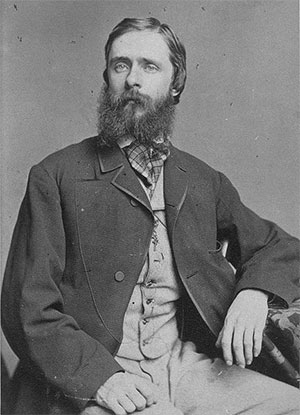
Bierstadt spent his later days in warmer climates with his ailing wife, Rosalie, who was diagnosed with consumption in 1876 and finally died of it in 1893. The warmer climate was thought to help people with her condition. Bierstadt died in February 1902 and was buried in New Bedford.
Not long after his death, the world, and the art world by extension, was transformed by world wars and radical new developments in art. Bierstadt’s style became something of a relic. Still, his talent could not be denied; critics rediscovered his work in the middle of the 20th century and it has now found a lasting place in the canon of art history.
Some have criticized the artist for his occasionally exaggerated perspectives, but the truth may be that the artist’s interpretation was based as much on his feelings as on what he saw. As he gazed on the sweeping, unsettled lands, he was awed by the impression that the open spaces went on forever. Surely Bierstadt imbued his work with recollections, feelings and the excitement of exploring new environments, and like many successful artists whose work is long-lived, he communicated his emotions with his brush.
Resources
Paintings of Wyoming Scenes—See Photo Gallery
Wind River Country, 1860
Wind River Country, a painting from 1860, the year after Bierstadt returned from his travels with Frederick Lander the road builder, gives us a regional perspective that is unique to Bierstadt’s style. The painting leads the viewer in from the left. Rugged trees, formed by the elements, twisted and broken--yet still beautiful, stand at the edge of a cliff. The cliff-side view is fairly common in Bierstadt’s work and serves to break up the space while creating the sense of grandeur and great distance. The middle ground is illuminated by the setting sun or perhaps a beautiful morning glow; more trees and a river, headed to some low mountains in the distance, wind through the center of the painting. Farther off, the viewer can see dark mountains and still farther away, snowcapped peaks. Soft clouds under an expanse of blue sky set a mood that is both serene and dramatic.
Island Lake, Wind River Range, Wyoming, 1861
The foreground streaks in from the right front of the canvas, a rocky outcropping with trees, some fallen, and verdant grasses invite the viewer into the painting to take a moment before looking out over the edge of the cliff into the vast wilderness. A river, that appears to drop into an unseen waterfall, cuts through the middle ground. Farther back one can see still more forested land and craggy cliffs. The river and falls settle into a large lake, which takes up the center of the painting. The distance fades into a soft, luminous wilderness. He used this kind of soft light to highlight certain parts of his work, but also to emphasize the expansive space. The way he showcased the West with a radiant light probably exposes his true feelings about the region—admiration and awe.
The piece recalls the European landscapes that so informed the artist’s mature style. Dazzling heights and great distances, perhaps a bit exaggerated, show the viewer the enthusiasm that Bierstadt had for the West. His subjects make clear how much he admired the unsettled landscapes and untouched beauty of Wyoming and the West.
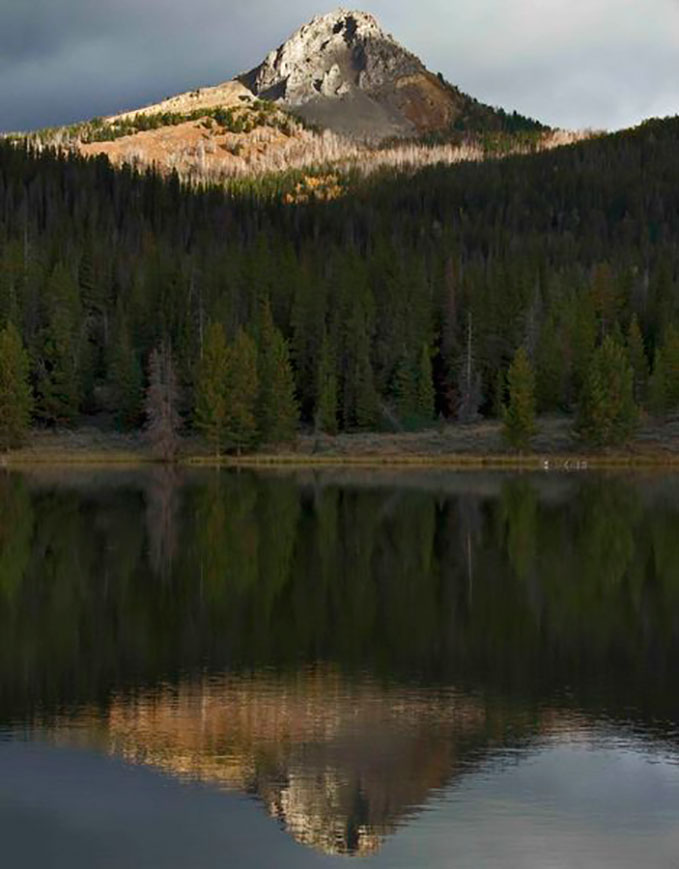
The Rocky Mountains, Lander’s Peak, 1863
The painting opens on an idyllic scene. The foreground plays host to a camp of plains Indians with tipis; horses and people all roam about involved in their daily routines. Behind the camp is a shimmering pond, fed by a waterfall pouring from the foothills. Trees and grasses are green, indicating spring or summer. Beyond the waterfall the mountains raise higher and higher, culminating with Lander’s Peak, touching the soft white clouds. This painting is different from many of his other works as it shows people and animals. He did paint humans and animals, but they often don’t appear in his most treasured paintings. Perhaps this is because much of his work is prized as a record of the West before European settlement, and it is still popular, though untrue, to imagine the West as largely uninhabited before white people got here.
Yellowstone Falls, 1881
Yellowstone Falls shows the now familiar shape of the falls, their waters spilling slightly to the left. Bierstadt set the painting as if rising up from a piney forest, the river winding below the falls and into the woodland. The mists at the bottom of the falls show the vague outline of a bird soaring above the raging waters. The painting itself is slightly less developed than his earlier works, suggesting that this was more of a study than a polished final piece. Bierstadt again guides the viewer into his painting in his familiar way by first anchoring the scene with a rocky outcropping before depicting an expansive view beyond. He employed this device time and again as a way to express the great and dramatic spaces he had seen.
Old Faithful, 1880s
The painting Old Faithful shows one of Yellowstone Park’s most dramatic and memorable sights. The foreground is broken by a number of trees, with a fallen pine leading the eye to a beautifully reflective stream that draws viewers deeper into the work. The namesake geyser sits in the center spewing its hot water and steam to the top of the painting. In the distance, the viewer can see a clouded sky and silhouetted pines. The regular intervals at which Old Faithful erupts apparently gave the artist ample opportunity to study the geyser and sketch it to make the painting.
Bibliography
- Anderson, Nancy. “Albert Bierstadt: A Letter from New York.” Archives of American Art Journal 40 (2000): 28-31.
- Campbell, Catherine H. “Albert Bierstadt and the White Mountains.” Archives of American Art Journal 21, no. 3 (1981): 14-23.
- “Fitz Hugh Ludlow.” Accessed March 14, 2014, at http://en.wikipedia.org/wiki/Fitz_Hugh_Ludlow.
- Hendricks, Gordon. Albert Bierstadt: Painter of the American West. Harry N. Abrams: New York, 1974.
- Houston, Alan Fraser and Jourdan Moore Houston. “The 1859 Lander Expedition Revisited: ‘Worthy Relics’ Tell New Tales of a Wind River Wagon Road.” Montana: The Magazine of Western History 49, no. 2 (Summer 1999): 50-72.
- Lamar, Howard R. ed. The New Encyclopedia of the American West (The Lamar Series in Western History), Yale University Press: 1998.
- Miller, Angela. “Albert Bierstadt, Landscape Aesthetics, and the Meanings of the West in the Civil War Era.” Art Institute of Chicago Museum Studies 27, no. 1 (2001): 40-59, 101-102.
- Merrill, Ross. “Albert Bierstadt and 19th-Century American Art.” Journal of the American Institute for Conservation 38, no. 1 (Spring 1999): 1.
- Pringle, Allan. “Albert Bierstadt in Canada.” American Art Journal 17, no. 1 (winter 1985): 2-27.
Illustrations
- The photos of Albert Bierstadt, Frederick Lander and Fitz Hugh Ludlow are from Wikipedia. Used with thanks.
- Bierstadt’s 1859 photo of the Shoshone warrior is from Territorial Kansas Online. Used with thanks.
- The contemporary photo of Lander Peak in the Wyoming Range is by Dave Bell, from Pinedale Online. Used with permission and thanks.
- Wind River Country, 1860. Oil on canvas. From the collections of the Denver Art Museum, Denver, Colo. Used with permission and thanks.
- Island Lake, Wind River Range, Wyoming, 1861. Oil on canvas, in the collection of the Whitney Gallery of Western Art at the Buffalo Bill Center of the West, Cody, Wyo. This image is from Wikipedia. Used with thanks.
- The Rocky Mountains, Lander’s Peak, 1863. Oil on canvas, in the collection of The Metropolitan Museum of Art in New York, NY. This image is from Wikipedia, used with thanks.
- Yellowstone Falls, 1881. Oil on canvas, in the collection of the Georgia Museum of Art, University of Georgia. This image is from Wikipedia, used with thanks.
- Old Faithful, 1880s. Oil on canvas. Image from Wikipedia, used with thanks.
